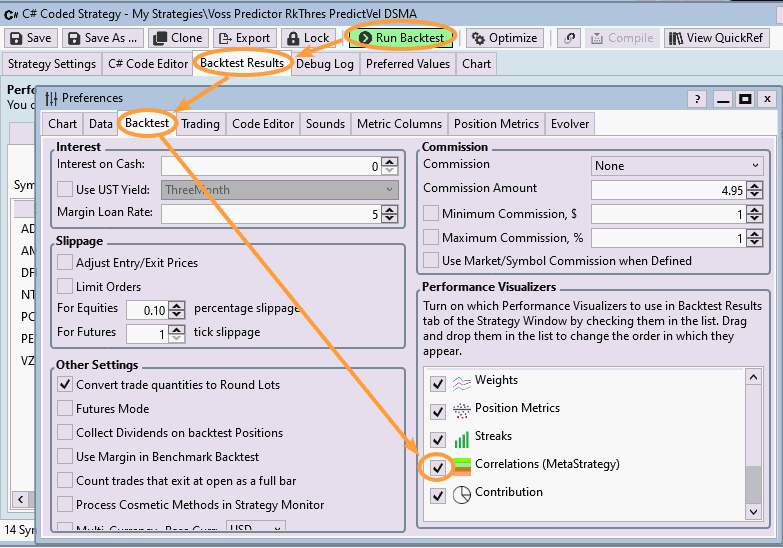Hey guys! Is there any way to test the covariance in a combination of strategies and do the appropriate balancing using wealthlab?
Rename
This question is incomplete. You want to test the covariance of what against what? Be specific.
Are we talking about the covariance between indicators within a single strategy run; perhaps a cross correlation between two time series? Or the covariance of performance metrics between strategies within a metastrategy? There is a performance visualizer for judging correlation of strategies within a metastrategy. Take a look at Reply# 7 in https://www.wealth-lab.com/Discussion/Laurens-Bensdorp-s-Automated-Stock-Trading-Systems-9377
This sounds like a problem you might want to pass to your stat package. I would have WL write out a data file native to your stat package so it could read the data in for an analysis. Your stat package is better equipped to analyze the residuals and compute Ps for the models in question you're trying to test against.
Are we talking about the covariance between indicators within a single strategy run; perhaps a cross correlation between two time series? Or the covariance of performance metrics between strategies within a metastrategy? There is a performance visualizer for judging correlation of strategies within a metastrategy. Take a look at Reply# 7 in https://www.wealth-lab.com/Discussion/Laurens-Bensdorp-s-Automated-Stock-Trading-Systems-9377
This sounds like a problem you might want to pass to your stat package. I would have WL write out a data file native to your stat package so it could read the data in for an analysis. Your stat package is better equipped to analyze the residuals and compute Ps for the models in question you're trying to test against.
Firstly thanks for the answer.
Yes, it would be to calculate the covariance of performance metrics between strategies within a meta-strategy.
I have used 20 strategies in a combination of strategies thinking about diversification, but I have noticed that many, despite being different strategies, have a correlation in performance. Therefore, I am looking for a solution to carry out this prior assessment of the performance of each strategy in the same period of time, where the performance correlation is the minimum possible.
Yes, it would be to calculate the covariance of performance metrics between strategies within a meta-strategy.
I have used 20 strategies in a combination of strategies thinking about diversification, but I have noticed that many, despite being different strategies, have a correlation in performance. Therefore, I am looking for a solution to carry out this prior assessment of the performance of each strategy in the same period of time, where the performance correlation is the minimum possible.
The Correlations performance visualizer is specific to a MetaStrategy. So the first thing to do is setup a MetaStrategy for all the strategies under test. Then you need to turn on the Correlations visualizer as shown below.

I see there isn't a discussion about the Correlations visualizer under the Performance Visualizer main heading of the Help docs. Perhaps someone might correct that.
Numerical analysis note: Although our linear system setup always uses the covariant system matrix, we never print that matrix out for human consumption because covariance metrics include "units". For making comparisons with human eyes, we convert it to a correlation matrix where the units are divided out. So for human evaluation, I like to think of it as a correlation matrix with the units (like Price) divided out.

I see there isn't a discussion about the Correlations visualizer under the Performance Visualizer main heading of the Help docs. Perhaps someone might correct that.
Numerical analysis note: Although our linear system setup always uses the covariant system matrix, we never print that matrix out for human consumption because covariance metrics include "units". For making comparisons with human eyes, we convert it to a correlation matrix where the units are divided out. So for human evaluation, I like to think of it as a correlation matrix with the units (like Price) divided out.
Also keep in mind that our Performance Visualizer API is open, so we could build new Visualizers (tabs) for MetaStrategies as well as normal backtests. You can make a #FeatureRequest for something general, or if it's very specific or you want to expedite you could leverage our Concierge Development service.
Thank you very much guys!
I'm still migrating to WL8. Knowing that it has this function makes me want to speed up this process!
I'm still migrating to WL8. Knowing that it has this function makes me want to speed up this process!
QUOTE:
... keep in mind that our Performance Visualizer API is open, so we could build new Visualizers (tabs) for MetaStrategies as well as normal backtests.
This is one of the primary reasons I personally use WL--it's extensible. You can also call external packages with it such as ScottPlot and Math.NET.
And for occasional modeling, you can always write out your dataset to disk for your stat package to read and workup.
Your Response
Post
Edit Post
Login is required